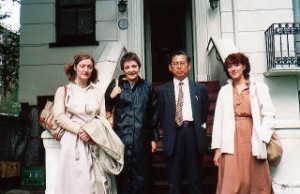菅長学園は、1967年に新しい形の幼児教育を目指して設立され、
40年間以上にわたって同じ信念で経営される児童教育施設です。
![]()
English Program
英語教育について、基本的考え方
1975年にハージェス先生を招いて以来40年以上、”音感覚を一番吸収しやすい幼児期に本物の英語にふれる”英語遊びは園の重要な日課になっています。
現在8人の外国人先生が常駐し園児達全員が毎日英語で遊んでいます。
言葉は「教えたり」「学んだり」するより、日常の中で自然に身に付いていくものです。周囲との関係性の中で、知らず知らず使っている・・・それこそが「生きた言葉」だと考えます。そんな風に生きた言葉として英語を習得していけたら、それは理想的すぎるでしょうか?海外生活をしなければ叶わない「夢」でしょうか?
「生きた英語」を修得するための「初めの一歩」となる・・それが菅長学園の英語カリキュラムの基本的考え方です。そのためには、話すことよりもまず聞くことです。それも録音された定型句や、機械の話す英語では無く、表情や身振り手振りを伴った人間の「生きた言葉」を・・・。
優しい声、怖い顔、厳しい視線、笑・・・それらの多くの感情表現と共に。
例え意味を理解できない音のつながりだったとしても、その音韻を様々な身体感覚と共に蓄えていく・・・。いつかその音の蓄積は「言葉」として意味を持つようになっていくはずです。人類がそうやって言葉を獲得し、人間になってきたように・・・。そして、「言葉」を獲得する次のステップとしては「勉強」も必要になってくるでしょう。
園の先駆的試みから約50年。
やっと小学校高学年の「英語必修化」が始まり、さらに低学年からの検討も始まっています。しかし週に一度程度の「お勉強」では、英語に慣れるどころか「英語嫌い」を増やすことになりはしないかとも危惧します。
英語の早期教育のマイナス面を指摘される方もいます。
いわく「まず母国語を大事にすべき」「国語も出来ないのに英語ができるか?」など…。確かにそれらの意見に頷ける所は多々あります。
だからこそ、園では「国語」や「読書力」に最も力を入れ、「挨拶」にはじまる「日本文化」への眼差しを忘れることはありません。
「米国文化」を無批判に導入しようとも思いません。大事なことは、この日本で生まれ育った、自分のアイディンティティーをしっかり育むことです。
世界を見れば、幸か不幸か、生まれながらにして幾つもの言語を覚えざるを得ない国の人々は沢山いる。それ故、例えばヨーロッパには、一人で何カ国語も話せる人たちが大勢いる。一方英国では、英語しかできない不幸が声高に嘆かれる始末…。
また、英語が帝国主義の歴史と結びついていることも指摘されます。確かに植民地化が英語の世界化に果たした役割は大きい、それは間違いありません。人間の歴史的営みに対する客観的な批判は尊重せねばなりません。そして英語は、その批判性や客観性を得意にしているように思えます。
英語を公用語にしている国は既に80カ国を超えると言われます。
世界で最も多くの国、地域で話され、「世界共通語化」していることは現実であり、アジア各国でも英語習得への取り組みは加熱しています。
地球は本当に狭くなりました。今この瞬間にも何千・何万という方々が地球を移動している。世界を対象にしない「経済」はもはやあり得ません。
子どもたちの未来への羽ばたきが、日本だけでなく、世界を視野に入れることは必須です。英語を話せることを目標にするのではなく、日本人として世界に羽ばたいていって欲しい! 幼児期の英語との親しみは、必ずや大きな財産になると信じます。事実、卒園生達から園での経験が「留学」や「海外での活動」に大変役に立ったという嬉しい連絡は幾つも届いています。もちろん、卒園後の本人の努力なくして実を結ぶことはなかったでしょう。ただその種を園でそっと植えてあげたい、そう願うばかりです。
For more than 30 years, playing in English “at early childhood when children are most responsive to sounds” has been an important aspect at Suganaga Gakuen. Currently, there are 8 full-time foreign teachers, and all students are exposed to English and have opportunities to play with the teachers daily.
I believe language is acquired through everyday activities rather than “teaching” and “learning”. It is acquired subconsciously through interactions…… that’s what I think of as “live language” (ikita kotoba). Is it too much to hope that children learn English as “live language”? Is it a “dream” unless you go overseas?
Offering first steps toward “Live English” (ikita eigo) is the aim of the English program at Suganaga. The very first step is to have students exposed to hearing native-level English rather than have them speak the language. I want students to hear live English of English speakers, and see their facial expressions and gestures which cannot be offered by recorded and mechanical English. Ideally, through “play” (asobi) rather than “study” (benkyo).
For learners, it may start as a chain of sounds that they can’t understand, but as the sounds become more familiar and associated with meaning, slowly they will start making sense as “language” (kotoba). Then gradually, “study” will follow.
Now English is compulsory at elementary schools. However, I’m afraid that once-a-week “study” may lead to “English dislike” (eigo girai). Language is language when it is close to one-self on one’s daily life.
There are people who are against teaching English from early childhood. They argue “Mother language should come first”, “is it possible to learn English before mastering Kokugo?”, etc. They may have points, but look at the world. Fortunately or not, there are people who have no choice but to acquire multiple languages. That is why many people in Europe are multi-lingual and they are the ones who hold important positions inside and outside of their native countries.
The world is getting smaller and smaller. At this very moment, thousands of people are moving here and there around the world. As we have seen in recent years, a sudden drop in the economy of one country can have repercussions all over the world. In order to complete in an increasingly globalized work force, children need to be exposed to people of different cultures and languages. I believe that being close to English from early childhood will be a great asset in their future. In fact, we get a lot of feedback from our graduates that the English program at Suganaga has been helpful and useful for studying and living overseas. Needless to say, they must have worked hard with guardians’ support, but I hope we can plant the seeds of potentiality at Suganaga Gakuen.
We offer three different programs for each grade based on the amount of time interacting with foreign teachers.
The “Regular Program” has one period (25 minutes) of English class daily to have students become accustomed to English. Although, the English time is limited to 1 period, the classes are daily and the students are surrounded by English atmosphere outside the classroom.
Students in the “English Program” have a well-balanced daily curriculum in which almost a half of it is carried out by English teachers and the other by Japanese teachers.
In the “Bilingual Program”, which is Suganaga’s flagship program, students spend most of the day with foreign teachers, with everyday instructions given in English.
When applying, please choose a program that meets your “ideals” and “principles”.
We often receive questions such as “How well will my kid speak English after 3 years?”. But please think about it. Even among adults, there are talkative people and reticent people. Don’t reserved people understand the language? That is not true. There must be many writers and scholars who have brilliant ideas, but are reticent in their day-to-day interactions. Please take a long-term view of your child’s future instead of a short-term goal.
However, I can promise this much. Within a year, students in the Bilingual Program will show appropriate reactions to instructions given in English by foreign homeroom teachers.
by Yasushi Shimazaki


アクセス
千葉県船橋市三山6-18-10

©suganagagakuen all rights reserved.
